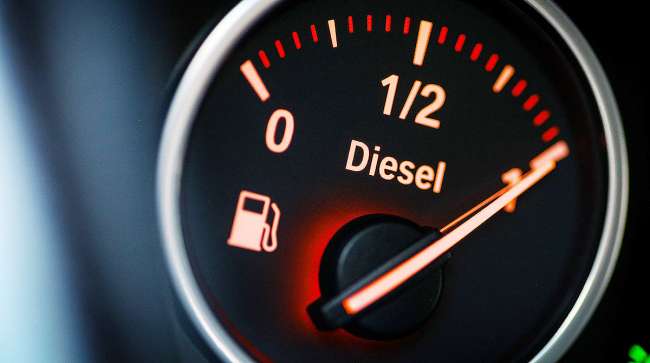Staff Reporter
Average Diesel Price Falls 2.7¢ to $3.01 Per Gallon

[Stay on top of transportation news: Get TTNews in your inbox.]
The U.S. average retail price of diesel fell 2.7 cents to $3.01 a gallon, the Department of Energy reported Jan. 27.
Trucking’s main fuel costs 4.5 cents more than it did a year ago, when it was $2.965 a gallon, according to DOE.
Regional diesel prices fell in all areas, tumbling the most in the Midwest, where prices dropped 3.6 cents to $2.901 per gallon.
Gasoline fell as well, by 3.1 cents to $2.506 a gallon, which is 25 cents more than a year ago. Gas fell in all regions of the nation, dropping the most in the Lower Atlantic, where the price sunk 5.4 cents to $2.344 per gallon.
Meanwhile, oil tumbled to the lowest level in more than three months as China’s coronavirus continued to bedevil the world’s second-largest economy, and after a U.S. government report showed the biggest rise in U.S. crude stockpiles since November, according to Bloomberg News.
#TodayInEnergy - EIA forecasts U.S. crude #oil production will keep growing through 2021, but more slowly https://t.co/VYGEgLSP1B #STEO pic.twitter.com/PQlBFwNTLr — EIA (@EIAgov) January 27, 2020
Futures in New York fell as much as 1.3% on Jan. 29. West Texas Intermediate crude for March delivery lost 47 cents to $53.01 a barrel on the New York Mercantile Exchange. Brent for March settlement fell 7 cents to $59.44 a barrel on the London-based ICE Futures Europe exchange and traded at a $6.43 premium to the U.S. benchmark, Bloomberg News reported.
One oil analyst told Transport Topics that OPEC would respond to decreasing prices by reducing oil production.
“It seems like the ‘fear trade’ may be over,” said Phil Flynn, energy analyst at the Price Futures Group of Chicago. “Probably because there is a sense that OPEC may act.”
Flynn said the coronavirus, thought to have originated in China, caused “demand destruction” in oil, but a move by OPEC could balance the market.
Another analyst is not so sure oil will hit new highs in 2020, even though 11 months are left in the year. Denton Cinquegrana, chief oil analyst at the Oil Price Information Service, told TT that U.S. oil production is approaching 13 million barrels a day, and inventories are solid.
But there are always wild cards, geopolitical and otherwise, that can affect the trade and supply of oil.
“A lot could happen the rest of the year,” Cinquegrana said. “[Nations] could start lobbing missiles at each other.”
Cinquegrana noted the oil market has overcome some once-thought big obstacles in January alone. One was the response to President Donald Trump’s order to kill Qasem Soleimani, commander of the Iranian Quds Force, on Jan. 3. The drone attack happened after a violent rally near the U.S. embassy in Baghdad. WTI oil approached $63 per barrel after the killing, but prices soon began to drop.
“If this were three years ago, higher prices would have hung around a while longer,” Cinquegrana said. “That’s a surprise right there.”
In part one of a two-part exploration of autonomous technology today, our latest RoadSigns podcast revisits conversations with CEOs Alex Rodrigues of Embark and Cetin Mericli of Locomation. Hear them explain what testing automated trucks and developing platooning technology has taught them about the road ahead — and get new perspective with host commentary. Listen to a snippet from Rodrigues above, and to hear the full episode, go to RoadSigns.TTNews.com.
The market has also not been greatly affected by the International Maritime Organization’s mandate that ships stop using bunker fuel, in favor of a lower-sulfur fuel. The regulation, which went into effect Jan. 1, was expected to put upward price pressure on diesel, as the new ship fuel draws from the same distillate stocks as diesel.
“It just hasn’t happened yet,” Cinquegrana said.
Fuel management still is important to fleets, even if prices are relatively low.
Laura McMillan, vice president of training program development of Instructional Technologies Inc., helps train drivers online — on issues of safety, compliance and fuel management. Fuel management is a key cost-saving measure that fleets look for to be incorporated into new drivers, McMillan told TT.
She said drivers are made aware of the fuel costs of a trucking operation, expenses that usually come in second only to labor.

McMillan
Best practices that Instructional Technologies teaches online are progressive shifting — shifting between what McMillan calls the “sweet spot” of 1,300 rpm and 1,500 rpm. The shifting in that range prevents overrevving the engine, burning more fuel, she said.
“Some drivers develop habits, without necessarily being mindful of that,” McMillan said.
The education for drivers on fuel is important, McMillan said, as “even a small amount of improvement over a fleet can add up.”
The lower prices also have not meant manufacturers are easing efforts to improve fuel efficiency. Magnus Koeck, vice president of marketing and brand management at Volvo Trucks North America, told TT that Volvo offers fleets three different packages of software and hardware to save diesel and reduce fuel costs. He said that is because fleets have different challenges in the use of fuel. Tankers, flatbeds and sleeper trucks all have differing fuel challenges, Koeck said.
“It totally depends on what you have,” he said. “For some applications, it doesn’t make sense to add all these aerodynamics. It has to make sense.”
Want more news? Listen to today's daily briefing:





